
The first HMS Montrose was one of eight Admiralty-type destroyer leaders, sometimes known as the Scott class. They were named after figures from Scottish history; Montrose was named for the Graham Dukes of Montrose. She was built during the First World War, but was completed too late for service then. However, she had a long career in the inter-war years and saw extensive service during the Second World War.

HMS Jaguar was a J-class destroyer of the Royal Navy. Commissioned in September 1939, she was present at the Dunkirk evacuation the following year, during which Jaguar was damaged by dive bombers. She later served in the Mediterranean and was involved in several actions there. She was torpedoed off the coast of Egypt on 26 March 1942 and sunk.
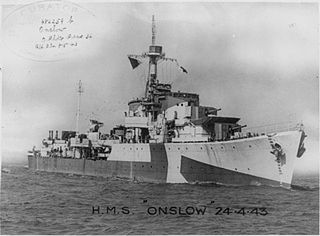
HMS Onslow was an O-class destroyer of the Royal Navy. The O-class were intermediate destroyers, designed before the outbreak of the Second World War to meet likely demands for large number of destroyers. They had a main gun armament of four 4.7 in guns, and had a design speed of 36 kn. Onslow was ordered on 2 October 1939 and was built by John Brown & Company at their Clydebank, Glasgow shipyard, launching on 31 March 1941 and completing on 8 October 1941.
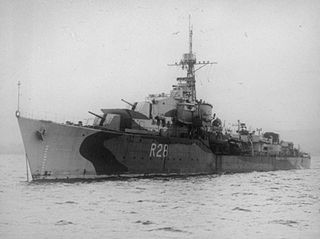
HMS Verulam was a V-class destroyer of the British Royal Navy that saw service during the Second World War.
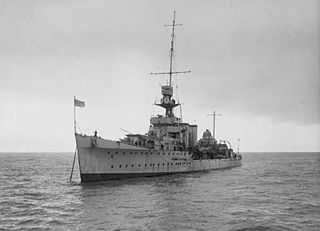
HMS Calcutta was a C-class light cruiser of the Royal Navy, named after the Indian city of Calcutta. She was part of the Carlisle group of the C class of cruisers. She was laid down by Vickers Limited at Barrow-in-Furness in 1917 and launched on 9 July 1918. Calcutta was commissioned too late to see action in the First World War and was converted to an anti-aircraft cruiser in 1939. Calcutta served during the Norwegian Campaign and the evacuation from Dunkirk in 1940. She was used to escort allied convoys across the Mediterranean and was sunk on 1 June 1941 by Luftwaffe aircraft off Alexandria, Egypt.

HMS Beaufort was a Hunt-class destroyer of the Royal Navy. She was laid down on 17 July 1940 at Cammell Laird, Birkenhead. She was launched on 9 June 1941 and commissioned on 3 November 1941. During the Second World War the ship served in the Mediterranean Sea, escorting convoys and covering landings. She was transferred to the Royal Norwegian Navy in 1952 and scrapped in 1965.
HMS La Malouine was a Flower-class corvette of the Royal Navy, serving during the Second World War. Originally ordered by the French Navy under the same name, following the fall of France, the ship was seized by the United Kingdom and commissioned into the Royal Navy in 1940. The corvette remained in service until being broken up in 1947.
HMS Marigold was a Flower-class corvette of the Royal Navy. She was launched on 4 September 1940 and was sunk by an Italian air-dropped torpedo on 9 December 1942.

HMS Westcott (D47) was a Royal Navy Admiralty W-class destroyer that served in the Second World War. In the Second World War Westcott served in an anti-submarine role and escorted numerous Atlantic and Malta convoys.

HMS Shikari (D85) was an Admiralty S-class destroyer of the Royal Navy. She was built by William Doxford & Sons, Sunderland and launched on 14 July 1919. She was one of the destroyers that took part in the Invergordon Mutiny. In 1933, she was briefly commanded by Frederic John Walker, who was to rise to fame as the foremost Allied submarine hunter of World War II.

HMS Bideford was a Royal Navy Shoreham-class sloop. She was named after the town of Bideford in Devon and was launched on 1 April 1931.

HMS Godetia was the second Flower-class corvette with that name built for the Royal Navy. She served during the Second World War as part of the Section Belge of the Royal Navy (RNSB). With the liberation of Belgium in late 1944, the vessel was returned to the United Kingdom. In common with other Flower-class corvettes, the ship was named after an eponymous flower.

HMS Douglas was an Admiralty type flotilla leader of the British Royal Navy. Built by Cammell Laird, Douglas commissioned in 1918, just before the end of the First World War. During the Second World War, Douglas served with Force H out of Gibraltar and as a convoy escort. She was sold for scrap in March 1945.
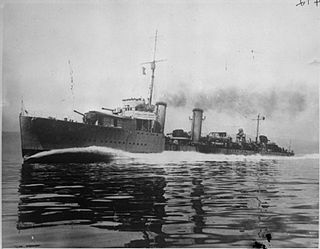
HMS Mackay was an Admiralty type, sometimes known as the Scott class, flotilla leader of the British Royal Navy. Mackay was built by Cammell Laird during the First World War, but was completed too late for service then, commissioning in 1919.

HMS Campbell was an Admiralty type flotilla leader of the British Royal Navy. Built by Cammell Laird, Douglas commissioned in December 1918, just after the end of the First World War. During the Second World War, Campbell mainly served with as a convoy escort, particularly on the East Coast of the United Kingdom. She survived the war, and was sold for scrap in 1947.

HMS Mallard was a Kingfisher-class sloop of the British Royal Navy. Completed in 1936, Mallard served through the Second World War, carrying out convoy escort operations off the east coast of the British Isles. She was sold for scrap in 1947.

HMS Deptford was a Grimsby-class sloop of the British Royal Navy. Built at Chatham Dockyard in the 1930s, Deptford was launched in 1935 and commissioned later that year. The ship saw early service on the Persian Gulf station, but the outbreak of the Second World War saw Deptford serving as a convoy escort in the North Atlantic and the Mediterranean, sinking a German U-boat in 1941. She survived the war and was scrapped in 1948.
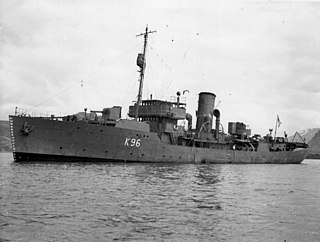
HMS Aubrietia (K96) was a Flower-class corvette built for the Royal Navy (RN) from 1941-1946. She was active as a convoy escort in the Atlantic and Mediterranean. In May 1941, Aubrietia sighted and depth charged the German submarine U-110, leading to its capture and the seizure of a German Naval Enigma and its Kurzsignale code book.

HMS Weston was a Shoreham-class sloop of the British Royal Navy. Weston was built at Devonport Dockyard in 1931–1933.

HMS Petunia (K79) was a Flower-class corvette that served in the Royal Navy and was built by Henry Robb in 1940. She was named after Petunia. Commissioned in 1940, rammed and sold to the Chinese Nationalist Government and renamed ROCS Fu Bo.



















